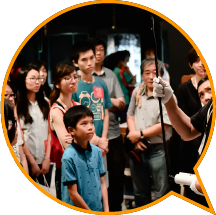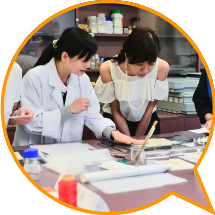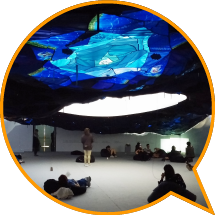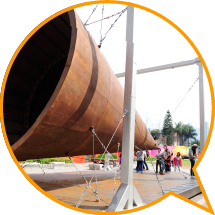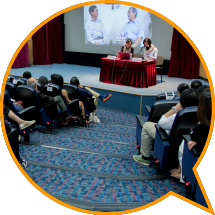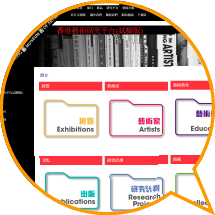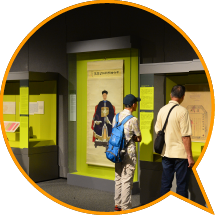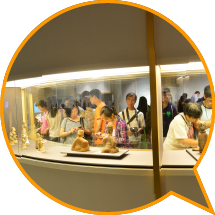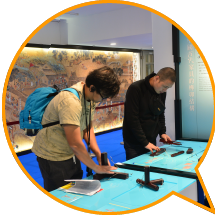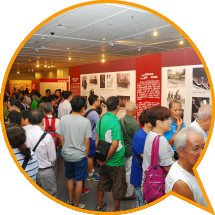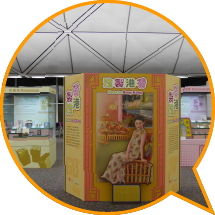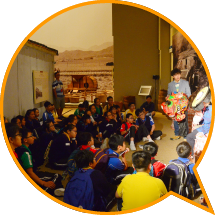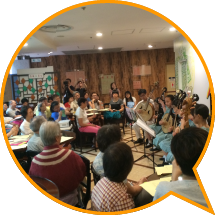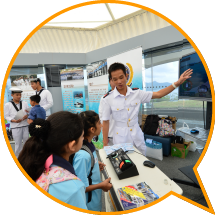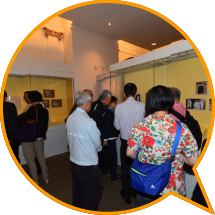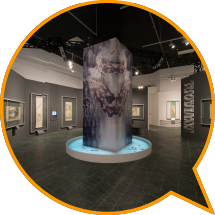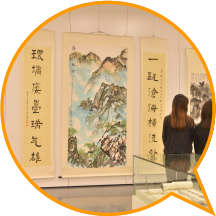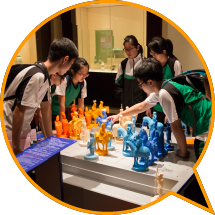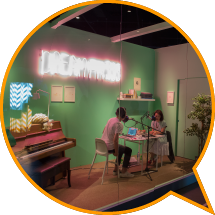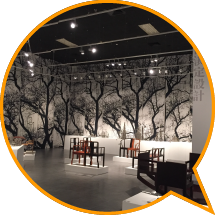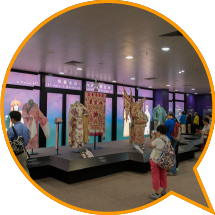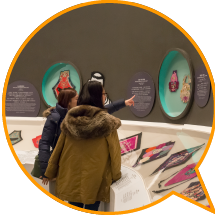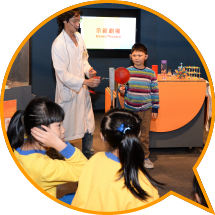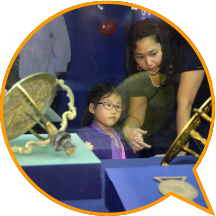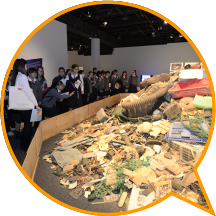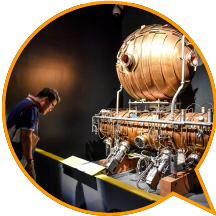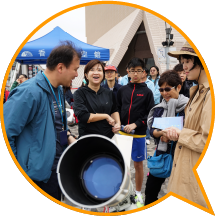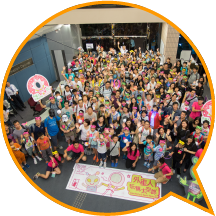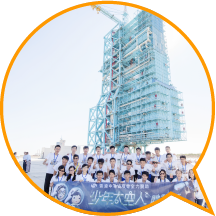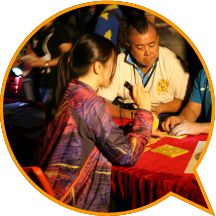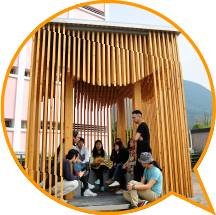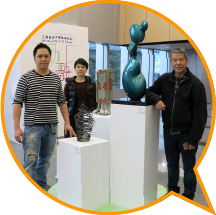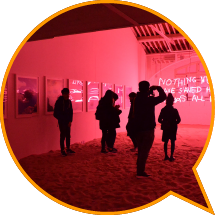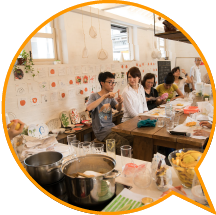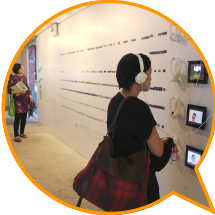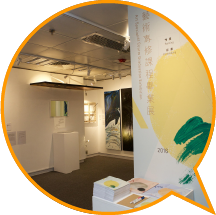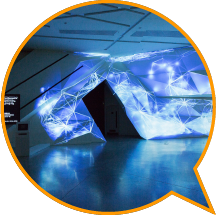The LCSD manages seven major museums: the Hong Kong Museum of Art, the Hong Kong Museum of History, the Hong Kong Heritage Museum, the Hong Kong Science Museum, the Hong Kong Space Museum, the Dr Sun Yat-sen Museum, and the Hong Kong Museum of Coastal Defence. Their roles are to acquire, conserve, research, exhibit and interpret both Hong Kong's tangible and its intangible cultural heritage.
The department also manages the Hong Kong Film Archive, the Art Promotion Office, the Hong Kong Heritage Discovery Centre, and the Ping Shan Tang Clan Gallery cum Heritage Trail Visitors Centre, along with seven smaller museums, namely the Flagstaff House Museum of Tea Ware, the Lei Cheng Uk Han Tomb Museum, the Law Uk Folk Museum, the Sheung Yiu Folk Museum, the Sam Tung Uk Museum, the Hong Kong Railway Museum, and the Fireboat Alexander Grantham Exhibition Gallery.
In 2015-16, over 4.5 million visitors patronised the LCSD's museums, enjoying many inspiring and enjoyable exhibitions and programmes designed for a wide range of audiences.
During the year, the LCSD published its fourth Five-Year Corporate Business Plan for the public museums, covering 2015-20. This lays out the vision, mission and core values of the museums, and their plans for achieving excellence. Individual museums and offices also drew up their own Annual Plans for 2015-16.
Transcend - Muse Fest HK 2015
In a move to raise awareness among the public of our local public museums and bring museum culture closer to the lives of ordinary people, in the summer of 2015 the department launched Muse Fest HK, the first ever museum festival in Hong Kong. The festival offered 72 programmes organised into four main categories: a Museum Inside Out Programme Series, an Exhibition and Film Show Series, an Educational and Extension Activity Series, and Muse Fest Special Activities.
Highlights of the festival included a Muse Fest HK Kick-off Party, along with special events such as the 'Be a Curator' Interactive Journey and the Alien Party@Space Museum, a Conservation Clinic, Heritage Walks, Museum HAS Family Workshops, and a series of curator's talks and behind-the-scenes programmes. All were very well received by the public.
Free Admission in January 2016
As one of the highlights of the Government's 'Appreciate Hong Kong' Campaign, a month-long 'Enchanting Museum' initiative was launched in January 2016 under which visitors enjoyed free admission to all museums of the LCSD.
Museum Advisory Panels
Three Museum Advisory Panels (Art, History and Science) are in place to enhance accountability and public involvement in the management of the museums. In the year under review, they continued to advise the department on the positioning of museums, on strategies for business development, marketing and community involvement, and on measures for enhancing operational efficiency and accountability. The panels comprise academics, museum experts, artists, art promoters, marketing and public relations experts, and community leaders.
Intangible Cultural Heritage Advisory Committee
The Intangible Cultural Heritage Advisory Committee monitors and advises on Hong Kong's intangible cultural heritage (ICH). The committee, which comprises local academics, experts and prominent community figures, commenced its fourth term on January 1, 2015, with an expanded membership incorporating a wider range of experts. Its terms of reference were also widened to cover the safeguarding of our ICH through research, promotion, enhancement, transmission and revitalisation.
Museum Trainee Scheme
The Museum Trainee Scheme was set up to develop a new generation of museum professionals. Trainees are attached to the Hong Kong Museum of Art, the Hong Kong Museum of History, the Hong Kong Heritage Museum, the Hong Kong Film Archive, the Art Promotion Office and the Conservation Office, and receive two-year on-the-job training in museum management or conservation services. The trainees learn how to manage museum services and organise education programmes, and also gain hands-on experience in curating exhibitions and projects. There were 26 trainee placements in 2015-16.
Hong Kong Museum of Art
During the year, the Hong Kong Museum of Art participated in Hong Kong Week 2015 and, for the first time, collaborated with the Museum of Contemporary Art, Taipei to organise In the Name of Art—Hong Kong Contemporary Art Exhibition. Featuring site-specific installation works by eight artists, this exhibition explored some of the core issues of contemporary art.
The Hong Kong Museum of Art joined hands with the Guangdong Museum and Macao Museum to co-organise the exhibition, 'Maritime Porcelain Road: Relics from Guangdong, Hong Kong and Macao Museums (Touring Exhibition in Mainland)', stationing in Zhejiang and Hubei during the year. The exhibition unveils the importance of Chinese export ceramics in the world. These two exhibitions recorded over 500 000 visitors.
As part of its efforts to collaborate with local art institutions, the museum partnered with the Asia Society Hong Kong Center in presenting a special exhibition titled Bat Cave: Treasures of the Day and Creatures of the Night. The exhibition offered contemporary interpretations of traditional Chinese art.
An outdoor exhibition titled Wall-less Chit-ChaNt opened in November 2015. This exhibition displayed two large-scale artworks created by Freeman Lau and Zheng Bo, and invited passers-by to chat, chant, and connect with each other. The museum also delivered a wide array of educational programmes to enhance public appreciation of art. In partnership with the Make A Difference Institute, a series of interactive activities were curated that offered participants a chance to get closer to artists and add creativity to their lives.
In summer 2015, in partnership with SCAD Hong Kong, the museum and the Friends of the Hong Kong Museum of Art co-organised a programme for senior secondary school students, Summer Art Cadets 2015 – Electronic Game Design and More. This two-week intensive art experience included workshops, lectures and tours. Students were able to access professional tools and learn about designing electronic games. In total, the museum's education and extension programmes attracted over 40 000 participants.
To encourage younger audiences to visit the museum, in October 2015 the museum launched a three-year education programme, the Jockey Club Museum of Art on Wheels Outreach Learning Programme. This is a moving museum that is visiting schools and district venues while the museum is closed. Offering a tailor-made programme for primary and secondary school students, it aims to bring art appreciation to schools through interactive, multimedia games and art jamming activities that are fun for all.
To deepen understanding of the development of art in Hong Kong and to enhance its archive of research materials, the museum began two new research projects in 2015, in collaboration with two non-profit-making organisations. The Hong Kong Art History Research Project (Phase II), undertaken in collaboration with the Asia Art Archive, was a continuation of the pilot research project completed in 2013 which studied the art ecology of the 1960s and 1970s. Panel discussion sessions were organised on October 10, 2015, at which project findings of the project were shared. Guest speakers included scholars, research experts and art practitioners. Another research project, A Survey of Western Media Art in Pre-1960s Hong Kong (Phase I), undertaken in collaboration with the Hong Kong Art History Research Society, studied the development of art in Hong Kong up to the 1960s. To coincide with the project, a seminar focusing on Western painting practices in Hong Kong was held on December 13, 2015. The principal researcher shared his findings and engaged in dialogue with guest speakers to explore the differences in art practices between today's artists and those practising before the 1960s.
To facilitate research work on Hong Kong art, the museum has set up the Hong Kong Art Research Portal, an online platform where data and materials from the Museum archive can be shared. In the pilot phase, we began by uploading our own material. In the second phase, we will be inviting other museums, academic institutions and research organisations to join our portal, with the goal of enriching this resource and promoting Hong Kong art research in the future.
The museum attracted over 117 500 visitors during the year. The Hong Kong Museum of Art was closed on August 3, 2015 for major expansion and renovation. The renovated museum is expected to open to the public in the second quarter of 2019.
Flagstaff House Museum of Tea Ware
The Flagstaff House Museum of Tea Ware is a branch of the Hong Kong Museum of Art. Its collection features tea ware and related implements from the collection of the late Dr K S Lo, as well as rare Chinese ceramics and seals donated by the K S Lo Foundation. In 2015, the museum jointly organised The Art and Culture of Yixing Zisha Stoneware exhibition with the Art Museum of the Institute of Chinese Studies of the Chinese University of Hong Kong and held the exhibition there from April 11 to October 4, 2015. It featured significant Zisha items from the collections of two museums and over 28 300 people visited the exhibition. The museum, which also organised many activities to introduce visitors to tea ware and the art of tea drinking, attracted over 214 700 visitors during the year.
Hong Kong Museum of History
The Hong Kong Museum of History aims to touch hearts and minds with unique stories of Hong Kong, and to broaden visitors' horizons through its explorations of human history. In addition to its permanent exhibition The Hong Kong Story, the museum regularly presents various thematic exhibitions either on its own or in conjunction with other museums and cultural organisations from Hong Kong, the Mainland, and overseas.
The year 2015 marked the 40th anniversary of the establishment of the Hong Kong Museum of History. To coincide with it, the museum organised the thematic exhibition Every Object Tells a Story in April and May of 2015. The museum specially selected 40 representative historical exhibits, such as glass negatives of photographs of the 'four bandits', a mooncake box from the Tak Wan Tea House in the 1960s, and sale brochures for the Mei Foo Sun Chuen development in the 1970s, and told the stories behind these significant collection items. The exhibition linked the items to the social, cultural and economic development of Hong Kong, and introduced the work of the museum in preserving Hong Kong history.
To commemorate the 60th anniversary of the discovery of the Lei Cheng Uk Han Tomb at Sham Shui Po, the museum together with Art Exhibitions China organised the thematic exhibition The Rise of the Celestial Empire: Consolidation and Cultural Exchange during the Han Dynasty. This was the largest in scale of its kind on the Han dynasty ever staged in Hong Kong. The exhibition showcased over 160 sets of priceless Han artefacts from more than 40 cultural institutes and museums on the Mainland, including a remarkable jade suit sewn with gold thread for the King of Chu, pottery figurines from the Han Yangling Mausoleum, and imperial seals from the Mausoleum of the Nanyue King. It offered insights into the rise and flourishing of the dynasty, and highlighted the cultural exchanges taking place between China and the rest of the world via the Silk Road some two thousand years ago.
The thematic exhibition The Radiant Ming 1368-1644 through the Min Chiu Society Collection was made possible with the generous support of individual members of the Min Chiu Society. Around 300 items from their valuable collections were put on display. They included porcelain, lacquerware, cloisonné enamels, jade pieces, textiles, furniture, gold and silver ware, paintings, calligraphy, scholar's objects, recreational objects and religious figures, all of which were presented in fresh ways that helped guide visitors through the history and culture of the Ming dynasty.
To commemorate the 70th anniversary of the victory of the Chinese people's war of resistance against Japanese aggression, the museum organised a number of special programmes in 2015, some in collaboration with other organisations. These programmes included an Exhibition in Commemoration of the 70th Anniversary of the Victory of the Chinese People's Resistance against Japanese Aggression and the World Anti-Facist War (held at the Hong Kong Convention and Exhibition Centre), an Exhibition Commemorating the 70th Anniversary of Victory in the War of Resistance against Japan (held at the Hong Kong Central Library), and a Pictorial Exhibition on China's War of Resistance against Japan, which toured to various cultural or community venues and included a lecture series, film shows, a seminar and a forum.
Since January 2016 the museum has also jointly organised an off-site display, Made in Hong Kong, with the Hong Kong Airport Authority, which is set up at the Hong Kong International Airport. The display showcases Hong Kong manufactured items and industries, including food, toys, watches and clocks, footwear, garments and electronics. Its aim is to illustrate the heyday of Hong Kong's manufacturing industries, with a focus on the flexibility, adaptability and creativity of local people.
Throughout the year, the museum organised a wide variety of educational and extension activities, including lecture series, seminars, workshops, conferences, field trips, film shows, competitions, historical dramas, as well as family and outreach programmes, all designed to cultivate public interest in local history and our cultural heritage.
The museum collaborated with the Hong Kong Academy for Gifted Education to organise the Future Curator Training Course in August 2015. Close collaborations with local universities and institutions, including the Hong Kong University of Science and Technology, the Chinese University of Hong Kong, the Hong Kong Baptist University, and the Centre for Hong Kong History and Culture Studies of the Chu Hai College of Higher Education, resulted in various public seminars and lecture series.
The museum continued its collaboration with the Art with the Disabled Association Hong Kong on the Interactivity Scheme, which offers sign interpretation guided tours and model-making workshops for people with hearing or visual impairments. At the same time, the Inclusive Life: Museum for All project offered special guided tours with sign interpretation and audio description, and model-making and touching workshops for those with hearing or visual impairments and those with intellectual disabilities. This enabled them to fully enjoy many of the treasures in the exhibitions The Rise of the Celestial Empire: Consolidation and Cultural Exchange during the Han Dynasty and The Radiant Ming 1368-1644 through the Min Chiu Society Collection.
A pilot project, Journey for Active Minds: Jockey Club Museum Programme for the Elderly, was launched in March 2014. This project provides special guided tours of and workshops on the museum's exhibitions for the elderly and for Alzheimer's patients. The aim of the project is to encourage participants to share their memories and experiences, interact with others, and learn more about Hong Kong's history, art and cultural heritage. A lobby display of the participants' works of art was staged in November 2015 to conclude the project.
The museum continued its collaboration with local community groups and non-profit-making organisations, including the Boys' and Girls' Clubs Association of Hong Kong, the Po Leung Kuk, the Heep Hong Society and the New Immigrants Service Association. Its Caring for the Community Scheme was run during the year for the elderly, new immigrants, teenagers, and ethnic minority groups, with the aim of fostering an understanding of Hong Kong's history and culture among these groups through extension activities such as story-telling sessions and model-making workshops.
During the year, more than 280 items were acquired from ongoing collection campaigns focusing on the cheongsam, children's life in Hong Kong, toys, and Hong Kong industries.
The Hong Kong Museum of History attracted over 764 000 visitors during the year. In addition to the Hong Kong Museum of Coastal Defence and the Dr Sun Yat-sen Museum, the Hong Kong Museum of History also manages three small branch museums – the Fireboat Alexander Grantham Exhibition Gallery in Quarry Bay Park, the Lei Cheng Uk Han Tomb Museum in Sham Shui Po, and the Law Uk Folk Museum in Chai Wan. They attracted approximately 88 200, 37 200 and 13 400 visitors respectively during the year.
Hong Kong Museum of Coastal Defence
The old Lei Yue Mun Fort in Shau Kei Wan has been transformed into the Hong Kong Museum of Coastal Defence, a branch of the Hong Kong Museum of History. Apart from its permanent exhibition, 600 Years of Coastal Defence in Hong Kong, the museum presented three thematic exhibitions during the year: Fighting as One: Reminders of the Eight Years' War of Resistance in Guangdong and Hong Kong; Great Victory, Historic Contribution Exhibition of the 70th Anniversary of the Victory of the Chinese People's War of Resistance Against Japanese Aggression and the World Anti-Fascist War; and Braving the Storm: Hong Kong under Japanese occupation. All these exhibitions commemorated the 70th anniversary of the victory of the Chinese people's war of resistance against Japanese aggression.
To celebrate the 15th anniversary of the Hong Kong Museum of Coastal Defence, the museum organised a series of public and special programmes in the latter half of 2015 which included a Fun Day, a drill performance, military music concerts, workshops, and a lecture series.
The museum attracted approximately 126 800 visitors during the year.
Dr Sun Yat-sen Museum
The Dr Sun Yat-sen Museum, housed in Kom Tong Hall, a declared monument, has two permanent exhibitions covering Dr Sun's life and his close connections with Hong Kong. In addition, two thematic exhibitions were organised during the year. The first was titled With the Passage of Time – Artefacts of Sun Wan, Dr Sun Yat-sen's Second Daughter, and her Husband, Tai Ensai; while the second one was called Wonderful Times, Beautiful Images - Calendar Posters and Modern Society in the Republican Period.
This museum attracted approximately 64 400 visitors during the year.
Hong Kong Heritage Museum
The Hong Kong Heritage Museum offered a diverse range of programmes and activities during the year, with a special focus on popular culture and design.
To celebrate the 110th birthday of the Lingnan Master Chao Shao-an, whose work is a special focus of the Hong Kong Heritage Museum, the museum organised the large-scale exhibition The Pride of Lingnan: In Commemoration of the 110th Birthday of Chao Shao-an from May to September 2015. The exhibition was a collaboration with the Guangzhou Museum of Art, and showed a selection of the best of both museums' collections. In addition, a special display was put on in the Chao Shao-an Gallery entitled Treasures Abroad: Works of Chao Shao-an from the Asian Art Museum, San Francisco, which showed works of the master collected in San Francisco. Over 93 800 visitors enjoyed the exhibition and display.
In recognition of Professor Jao Tsung-I's contribution to the research and promotion of traditional Chinese culture, the Hong Kong Heritage Museum joined hands with Jao Tsung-I Petite Ecole of the University of Hong Kong to organise the Reminiscences of Hong Kong by the Brush: A Celebration of the 100th Birthday of Professor Jao Tsung-I exhibition at the Hong Kong Central Library in December 2015 to coincide with the celebration of Professor Jao's 100th birthday. Selected exhibits included paintings and calligraphy by Professor Jao, as well as a collection of his academic masterpieces, manuscripts and letters. The exhibition presented a comprehensive survey of the master's academic and artistic accomplishments over the past eight decades.
To complement the Bruce Lee: Kung Fu • Art • Life Exhibition, the museum added a new display in Series II of the Memorable Bruce Lee:Collectors'Corner. The display features Bruce Lee items from the collection of the noted American collector Jeff Chinn, which highlight Lee's dynamic achievements in film.
The Past is Continuing exhibition was curated in a way that offered visitors a unique and dynamic opportunity of experiencing history, art and culture. The 18 contemporary artists involved in the exhibition drew inspiration from historical and cultural artefacts in the museum's permanent galleries to create new artworks in different media. These included paintings, ceramics, product designs, fashion designs, new media, music, sculpture, photographs, installations and mixed media works, all of which reinterpreted tradition within the contemporary context. Displayed in different permanent galleries of the museum, the exhibits took visitors on a journey through time and space, and introduced visitors to some unique examples of local art.
In another exhibition, Walking in the Dreams, 11 local artists working in different media (Chinese painting, environmental art, theatrical art, sound art, sculpture, ceramics, new media, installation and photography) were invited to create artworks that shared their personal experiences of dreaming and interpretations of dreams, and that deconstructed dreams from psychological, scientific, social and historical perspectives.
The museum also showcased Freeman Lau & Design: Inter-dependent Decisions in 2015, to pay tribute to the achievement and contribution of this local design master. The exhibition featured representative works by Lau from over the years, including cultural, commercial and public art space projects that are intimately connected with the social development of Hong Kong. Some of his unique crossover works, including his Chairplay series, were also on display.
In tribute to Dr Lam Kar Sing, an opera great who passed away in August 2015, the museum organised the exhibition A Voice for the Ages, a Master of his Art – A Tribute to Lam Kar Sing from September to November 2015. Featuring photos, theatrical costumes and other materials connected with Dr Lam, the exhibition revisited Dr Lam's spectacular performing career and highlighted his great contributions towards helping preserve Cantonese opera.
Jointly presented with The Memorial Museum of Generalissimo Sun Yat-sen's Mansion, the exhibition Wearable Blessings: Traditional Chinese Children's Clothing featured over 200 sets of children's clothes and accessories. Exhibits were selected from the collections of the two museums in Guangdong and Hong Kong as well as from the Naidongtang collection in the US. The items dated from the late Qing dynasty to the Republican period. The exhibition also presented examples of children's wear designed by the Institute of Textiles & Clothing of the Hong Kong Polytechnic University. The different items incorporated traditional auspicious patterns in their designs while using modern styles and craftsmanship, offering visitors new insights into Chinese children's wear.
The museum continued to participate in the Arts Buddies project. In 2015-16, the programme was jointly organised by the Education Bureau, the Hong Kong Arts Development Council, the Institute of Creativity and Academic Community Hall of the Hong Kong Baptist University, and the Office of the Arts Administrator of the Chinese University of Hong Kong. This project offered a series of training programmes to secondary and tertiary students that enhanced their knowledge of and bolstered their skills in arts appreciation and art promotion. The museum also collaborated with the Education Bureau in running gallery talks, workshops and seminars in support of Life-wide Learning and the Senior Secondary Curriculum.
In conjunction with the Chief Executive's Award for Teaching Excellence Teachers Association, the museum organised two symposiums to complement the exhibition Freeman Lau & Design: Inter-dependent Decisions.
The Hong Kong Heritage Museum attracted over 430 100 visitors during the year. The museum also manages three branch museums: the Sam Tung Uk Museum, the Hong Kong Railway Museum, and the Sheung Yiu Folk Museum. These three branch museums attracted approximately 91 300, 223 800 and 40 000 visitors respectively.
Hong Kong Science Museum
The aim of the Hong Kong Science Museum is to popularise science for people of all walks of life, and to help members of the public to better understand the relationship between science and our daily lives.
The Strange Matter exhibition, held from December 12, 2014 to April 15, 2015, introduced visitors to the amazing world of modern materials through a host of interactive activities. Visitors were able to interact with various types of materials (such as ferrofluids, amorphous metals, memory metals and foam), each of which involved quite unique experiences. The exhibition was produced and provided by the Ontario Science Centre of Canada and the Materials Research Society, and welcomed over 175 000 visitors.
Jointly organised with the Palace Museum, the exhibition Western Scientific Instruments of the Qing Court, held from June 26 to September 23, 2015, was an exhibition that merged science and history. Some 120 examples of precious instruments and related objects from the Western science and technology collection of the Palace Museum were displayed. They illustrated the scientific and cultural exchanges that took place between China and the West in the Qing dynasty, and demonstrated the importance of science and technology in the ability of societies to advance. In addition, the museum designed a number of multimedia and interactive exhibits to illustrate the workings of these scientific apparatuses, and the underlying scientific principles that allow them to work. The exhibition attracted over 139 000 visitors. After the exhibition had concluded, the Shandong Museum invited the museum to include its own exhibits alongside the treasures of the Palace Museum in the exhibition Appreciation of the Western Science and Technology from Qing Emperors, held from December 1, 2015 to February 28, 2016 at the Shandong Museum. The exhibition was well received by the citizens of Jinan, Shandong, attracting attendance of more than 180 000 visitors.
A thematic exhibition titled Out to Sea? The Plastic Garbage Project was held from November 27, 2015 to February 17, 2016. It presented different works of art made using plastic waste to show how plastic waste is threatening the entire marine ecosystem. This exhibition powerfully illustrated the unfolding ecological catastrophe by combining elements of science and art. The centrepiece display, made up of a large pile of plastic debris collected from seas around the world, dramatically captured the attention of visitors. In addition, interactive exhibits and audiovisual programmes introduced the science behind plastic products and the threats they present to the earth. The museum also invited students from Project WeCan to take part in beach clean-up activities, and to make artworks from plastic garbage for display in the exhibition. The exhibition was very successful, welcoming over 128 000 visitors.
The exhibition Collider: Step inside the World's Greatest Experiment was held from March 18 to May 25, 2016. It introduced the world's largest and most powerful particle accelerator, the Large Hadron Collider, which is helping uncover the secrets of the universe through particle physics experiments. The exhibition included multimedia programmes that simulated laboratory environments and real components of the Collider, including a 2-tonne superconducting magnet. These were effective in presenting the special structure and detectors of the experimental facility, and highlighting the role it plays in enabling cutting-edge research in particle physics. In addition, the exhibition also highlighted the role of scholars and scientists from Hong Kong in the research being conducted at the European Organization for Nuclear Research (CERN). Up to March 31, 2016, the exhibition had attracted over 32 000 visitors.
During the year, over 1 124 800 people visited the exhibitions and took part in the museum's education and extension activities.
Hong Kong Space Museum
The Hong Kong Space Museum promotes astronomy to members of the public through exhibitions, planetarium shows and extension activities. Equipped with advanced projection and control systems, the Stanley Ho Space Theatre offers awe-inspiring experiences through its Omnimax, 3D Dome Shows and Sky Shows. The interactive exhibits enable visitors to explore topics in space science in entertaining and educational ways.
On March 9, 2016, a partial solar eclipse was visible in Hong Kong. Taking advantage of this special astronomical phenomenon to promote astronomy, the museum conducted observation activities at the Tsim Sha Tsui waterfront and in Statue Square in Central District. Around 450 people attended these activities.
Developed for screening using a digital planetarium projection system, Decoding Starlight took audiences on a journey in the footsteps of astronomers as they unlocked the secrets of the stars. This was the second full-dome Sky Show to be produced by the museum, and is packed with animated scenes and stunning visual effects. The show will be staged for eight months from March 2016.
As part of the International Year of Light 2015, a special exhibition titled Multi-wavelength Universe was displayed in the museum lobby in 2015. The exhibition introduced the way lights of different wavelengths have been used to explore celestial objects.
Alien Party @ Space Museum, a highlight programme of the first Muse Fest HK, was held in June and July 2015. Around 200 participants, some dressed up in alien costumes, joined in the fun-filled evening. The possibilities of extraterrestrial life were explored through sky shows, games, a stargazing programme and a workshop.
Jointly organised with the Chinese General Chamber of Commerce, the China Astronaut Research and Training Center, the Jiuquan Satellite Launch Center and the museum, the Young Astronaut Training Camp selected 30 local secondary students from 200 nominees to take part in a space science and astronaut training camp. Participants travelled to Beijing and Jiuquan between July 31 and August 7, 2015, enjoying a highly rewarding learning experience.
A Stargaze Camp for All and the Blind was held on October 17, 2015 in the field area adjacent to Astropark in Sai Kung. Involving more than 40 supporting organisations, the Camp welcomed 2 200 participants including people with visual, hearing and physical impairments, and members of underprivileged and ethnic minority groups. Booth activities and observation programmes were organised that offered participants the chance to experience the pleasures of stargazing.
The museum's stargazing mobile app, Star Hoppers, has proved very popular, having been downloaded more than 83 000 times since its launch in 2014. Targeting all interested in stargazing, the app includes Chinese and Western star charts, audio recordings of the stories of the constellations, and information about astronomical events and related activities. The app was selected as a Certificate of Merit winner in the Category 'Games & Edutainment'in the Asia Smartphone Apps Contest 2015.
During the year, the museum presented one Sky Show, one 3D Dome Show, two Omnimax Shows and two School Shows. The Stanley Ho Space Theatre programmes attracted around 247 000 visitors.
Around 286 800 people visited the Hall of Space Science, the Hall of Astronomy and nine special exhibitions, while over 28 000 people participated in over 470 sessions of extension activities. The permanent exhibition halls of the museum have been closed for renovation since October 2015, and are scheduled to re-open by 2017.
Art Promotion Office (APO)
The APO, in co-operation with various partners, organised a series of community and public art projects in 2015-16 designed to enrich cultural life and encourage public appreciation of art.
ARTivating Public Buildings is a public art project aimed at giving the public more opportunities to access art in their busy daily lives, by transforming some public areas of government buildings into interesting art spaces. In July 2015, four sets of site-specific, community-related artworks were installed in the Stanley Municipal Services Building, the Tung Chung Municipal Services Building, the Tai Kok Tsui Municipal Services Building and the Lung Yat Community Hall. These commissioned art pieces will be on display until July 2017. Throughout this period, fringe activities such as guided tours and workshops have been held to enrich the overall experience of viewers.
The Public Art Scheme 2015 was launched in December 2015. After being selected through an open competition, four local artists or art groups were commissioned to create and instal artworks in the Lam Tin Complex, the Tiu Keng Leng Public Library, the Tiu Keng Leng Sports Centre, and the Ping Shan Tin Shui Wai Public Library in early 2017.
The Fusion Sculpture Exhibition is a pilot art display project in the Trade and Industry Tower, the first government building with space dedicated for art display purposes. The aim of the project is to provide building users and members of the community round about with a range of art experiences. The exhibition, which is a collaboration with Hong Kong Sculpture, will showcase more than 20 artworks from January 2016 to December 2016.
Energizing Tsun Yip Street Playground as Kwun Tong Industrial Culture Park (Phase 1) is a collaborative project undertaken with the Energizing Kowloon East Office. Under Phase 1 of the project, four containers were transformed into exhibition pavilions to showcase Kwun Tong's industrial development, open for visitors until August 2017. Building on the momentum of phase 1, a Public Art Scheme of the Tsun Yip Street Playground initiative will be launched in September 2016, forming part of phase 2 of the playground renovation project. Up to seven public artwork pieces focused on specific local industries will be selected through an open competition, and installed in the Tsun Yip Street Playground in 2018.
Oil Street Art Space (Oi!)
Oi! is an open platform for young local artists where ideas about art can be exchanged. It aims to promote art at the community level, and has developed into an innovative venue that encourages collaboration and co-creation in art.
In 2015-16, Oi! organised the annual exhibition Before‧After. Local artists Samson Young and Tung Wing-hong, and art group L-Sub, were invited to present projects exploring the process of art creation. The Beijing artist Song Dong created a Doing Nothing Garden using leftover community resources, and invited public interventions throughout the exhibition period. Oi! also organised a number of public engagement programmes, including XCHANGE: Social Gastronomy, E-pathy City and the Connecting People series. Oi! has become a valuable platform for social engagement with the local neighbourhood.
The Sparkle! exhibition series sets out to bring art into daily life by presenting the aspirations of a new generation of artists. In 2015, Oi! organised two exhibitions under this series, Sparkle! Let's Art, and Sparkle! After One Hundred, curated by Vivian Ting and Cheng Yee Man (Gum) respectively. The curators invited local artists to conduct research into the North Point district, and encouraged them to work with different communities to produce their artistic creations. The exhibition artworks included installations, paintings, videos and prints.
Hong Kong Visual Arts Centre (vA!)
vA! provides a platform for art learning and exchange between artists, art enthusiasts and the general public. It does this by establishing partnerships with artists, relevant institutions and art organisations, and working together with them to organise quality activities that meet ever-changing public demand and give participants the opportunity to enjoy creating and participating in art.
In 2015-16, vA! organised its signature programme the Art Specialist Course, a year-long art training programme for amateurs and young artists. In addition, it organised POST PiXEL. Animamix Biennale 2015-16 in collaboration with the City University of Hong Kong, promoting new media art. A forum titled Dialogue! Tactic‧Strategy was also held to foster cultural exchange. Workshops on new media art and studio art practices were also organised that gave participants a better understanding of how contemporary art is being created.
Intangible Cultural Heritage Office (ICHO)
Hong Kong's first ICH inventory was promulgated in 2014, followed in 2015 by the existing ICH Unit under the Hong Kong Heritage Museum being upgraded to become the new ICHO. The ICHO has put in place measures to enhance the safeguarding of local ICH items, measures which include strategies for their identification, documentation, research, preservation, promotion and transmission. In consultation with the ICH Advisory Committee, the ICHO is in the process of selecting certain items of higher cultural value from the inventory for more in-depth study, with a view to drawing up the first representative list of local ICH. The representative list will provide the Government with a basis for prioritising resources for safeguarding ICH items.
Various ICH items and ICH bearers were featured in exhibitions and displays during the year, such as the exhibition Genesis and Spirit: Intangible Cultural Heritage of Gansu and displays of paper craftworks by local masters at urban lantern carnivals and at the Hong Kong International Airport. Since November 2015, the ICHO has been using the Sam Tung Uk Museum in Tsuen Wan to house regular exhibitions along with education and promotion activities. Its first exhibition was The Oral Legacies - Intangible Cultural Heritage of Hong Kong, featuring 10 local items inscribed on China's national list of ICH together with the relevant bearer organisations, and on display at the Sam Tung Uk Museum since February 2016. The ICHO will continue its collaborative efforts with bearer organisations of ICH items and other community organisations to raise public awareness of and interest in ICH, by providing activities such as festivals, exhibitions, displays, talks, workshops, seminars, and field visits.







